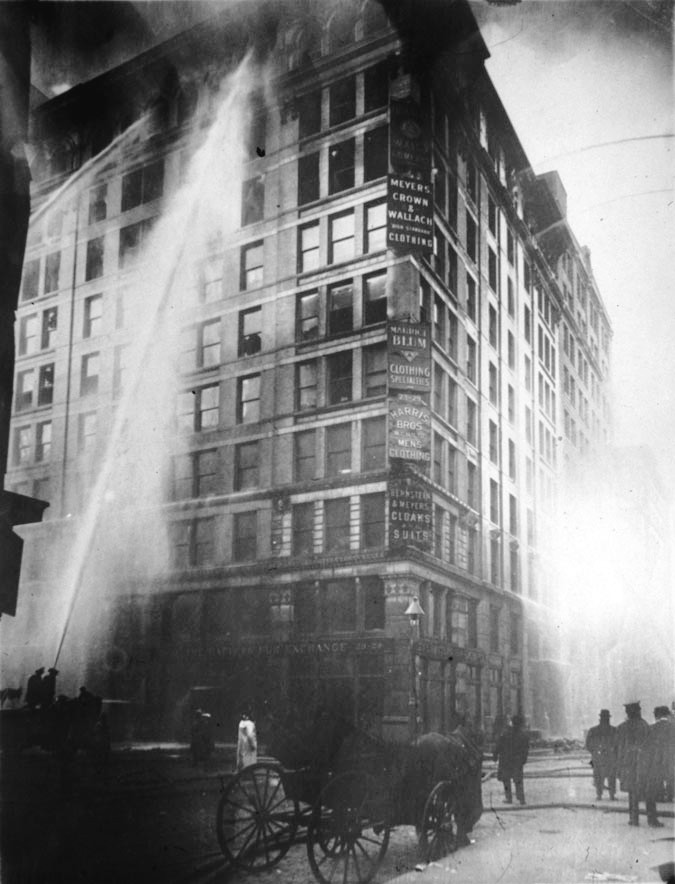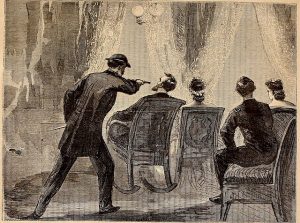It was March 25, 1911, in New York City. It was a Saturday afternoon just like any other at the Triangle Shirtwaist factory, where young immigrant women sat in front of sewing machines, day in and day out, sewing. But on that day a fire broke out, causing the deaths of 146 garment workers. Among those who died in the flames and smoke were 123 women and 23 men.1 Many even jumped or fell to their deaths out the windows, making this event a man-made disaster and one of the deadliest industrial disasters of all time.

The factory was located in the Asch Building at Washington Place in Greenwich Village, one of the wealthiest neighborhoods in the city. The factory occupied the eighth, ninth, and tenth floors of the ten-story building. Max Blanck and Issac Harris were the owners of the factory, and their company was known as the largest firm in the business at the time. They styled women’s blouses known as “Shirtwaists,” which were paired with tailored skirts. This attire had become the standard in fashion for women in the early twentieth century. They were also known to resemble men’s shirts. When it came to their workers, they had hired operators who then contracted out for factory workers. The company itself only dealt with the contractors, and there was no fixed rate of pay for the workers.2 At the time, the factory employed about five-hundred employees, mostly young immigrant women who were of Italian or Jewish descent. These women worked up to eleven-hour shifts on weekdays, and twelve-hour shifts on Saturdays, and they earned between $7-$12 dollars for a 52-hour week. Many of these women were the breadwinners of their household, and their income was sometimes not sufficient to cover their needs.
Towards the end of the workday on that Saturday evening in 1911, a fire broke out around 4:00 pm. The fire started in a scrap bin under one of the cutter’s tables on the eighth floor from what is believed to have come from a cigarette. A manager tried to put the fire out with a hose but the hoses valve was rusted shut, and rotten away. The fire spread quickly and the workers panicked. There was one fire escape that quickly collapsed, and four elevators, which out of the four only one was working. The elevator held twelve people at a time, and it managed to make four rescue trips before it broke down.3 With no other alternatives available, people began throwing themselves out the windows, and some were even crushed to death trying to get out. Workers tried to take the stairs, but the exit doors only opened inward and were kept locked by factory management to prevent theft by the workers, as the managers would check their workers belongings every day before they left for the day.

Celia Saltz Pollack, a survivor of the 1911 Triangle Shirtwaist Fire said,
I remember on that day there was a lot of singing and happiness in the shop because it was the end of the week and we got paid. We were soon all going to go home. When the fire started I was sitting at my machine. I looked up and saw the fire near the cutting tables but I did not think it was so terrible. What was terrible was that the fire spread in a split second.
By the time the firefighters arrived, they came to the realization that their ladders could only extend up to the sixth or seventh floors. With no other option, sixty-two workers jumped and fell to their deaths, while the remaining died from the smoke and flames within the building.4

This fire not only pushed issues of unsafe factories and immigrant exploitation into the public consciousness, but for the first time the fire allowed for attention to be brought to deplorable conditions of New York factories.5 Women obtained well deserved attention onto current work conditions and safety measures in the workplace. Although the Triangle Shirtwaist Factory fire brought a feeling of resentment and heartbreak to many, this event and its victims will always be remembered.
- Ric Burns, “Triangle Shirtwaist Fire,” New York Times (1923-Current File), Nov 24, 1999. ↵
- Jonathan Fink, “Conflagration and Wage: The Triangle Shirtwaist Factory Fire, 1911,” TriQuarterly, no, (2009): 135-136. ↵
- Gale Encyclopedia of U.S. Economic History, s.v. “Triangle Shirtwaist Fire,” by Thomas Carson and Mary Bonk. ↵
- Mia Lynn Mercurio, Régine Randall, “Tributes Beyond Words: Art Educators’ Use of Textiles to Memorialize the Triangle Shirtwaist Factory Fire.” Journal for Learning through the Arts no. 1 (2016): 4-5. ↵
- Albert Marrin, Flesh and blood so cheap: The Triangle fire and its legacy (New York: Alfred A. Knopf, 2011), 23-25. ↵




135 comments
Lyle Ballesteros
A well written sory that is very said but needed to be told and an important marker in American worker history. It was an awful day but an important one in a couple ways you mentioned in that an eye was shone upon the conditions workers in America and New York specifically had to work in and that it had to improve and that there had to be more safety measures for when accidents and disasters happen in the future, so next time not so many if any people die when they should not.
Madison Magaro
The author did a great job at explaining what happened on March 25, 1911, in New York City at the Shirtwaist Factory. It is crazy that management locked the doors on the employees because they were not producing enough product. Since the doors were locked when the fire broke out it caused 146 workers there lives. It is sad to see that the firefighters were not able to save some because of how unprepared they were.
Gabriella Galdeano
The writing in this article was good! The little pay for the women is baffling. They deserved so much more for having such long hours. They also deserved better working conditions. A fire escape that quickly collapsed and only one working elevator is cruel. This tragedy highlighted why safety measures are crucial. Unfortunately, the loss of life is what it took to improve working conditions, but I am glad that buildings now have to meet standards to be deemed safe.
Jaedon E
Very intriguing article! This is something that should be taught within American History. Due to its vital affections on the safety measures in factories. It’s very sad to learn about how disaster can take place and either injure or visualize the death count. What stood out to me was reading about how some of the workers would jump out of the building to do anything for survival because there was no other way out. When reading that that made me think about 9/11, about how the people trapped wanted to live and jumped out the windows of the twin towers.
Overall great topic!
Sierra Christa
This article made me extremely frustrated and upset that this even happened at the hands of negligence in the workforce. These women were working to simply live and because the people in power wanted more money or profit. The image of the women laying in the street is heartbreaking as those women really had no choice and were forced to burn or jump. This article told the story well and portrayed the tragedy of the event well.
Clarissa Liscano
I was shocked to learn about how the women at the Shirtwaist Factory were treated and essentially abandoned to die. I had no idea how quickly a fire might spread, how helpless these women were, that only one of the four elevators was operational at the time, and that the only other option was to leap out the window, although some people were 6 to 7 stories high and would do so to their detriment. This article does an amazing job of describing how inadequate maintenance and a lack of escape routes effectively confined the workers.
Danielle Sanchez
This article contained great images that brought the story to life. The Triangle Shirtwaist factory fire was the result of 146 deaths of garment workers. The factory was the workplace of 146 garment workers which was located in Greenwich Village. The tragic fire broke out on that Saturday evening around 4:00 pm. The fire spread quickly and many workers tried to take the stairs but the exit doors were locked courtesy of the management of the factory.
Ian Poll
Everything that could go bad for the workers got worse with this fire. Poor maintenance, little planning and not enough escapes caused the workers to be trapped. It is very sad to read how many people died, but it did help reveal the mishandling of factory workers and their environment which further developed regulations for fire safety. It is a horrible tragedy and even worse that firefighters were unable to reach people due to how ill equipped the firefighters were
Abbey Stiffler
I cannot imagine what I would’ve done if I had worked in the Shirtwaist Factory. It shocks me as the fire spread so fast that no one could do anything. I can’t believe only 1 out of 4 elevators was working as I would think that would have been an issue fire or not. I do not think I would have the guts to jump from 7 or 8 stories high to my death as some did.
Andrea Tapia
This was one of the most heart-breaking articles I’ve read so far. It gave me goosebumps just even thinking about how they must have felt. Especially knowing that they were all happy and about to get paid to split seconds leading to their death. Knowing that the elevators weren’t working well, the doors were kept locked for thefts, and there was no fire escape plan. There needs to be more attention in planning ahead to know what someone can do if there is a fire. Today we have more safety, but we still face many sad disasters every day. You will never know when it would be your last time on this earth, but till today these people will be remembered forever. It gave me chills when I heard that some jumped or fell out the window to their deaths. This reminded me of 911 and how a beautiful day can turn into one of our biggest nightmares. Overall, great article and I loved how well it explained the whole thing.